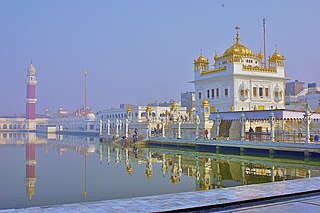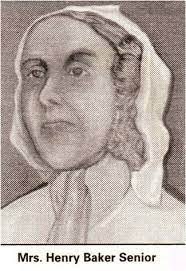Related Research Articles

Tarn Taran Sahib is a city in the Majha region of the state of Punjab, in northern India. It is the district headquarters and hosts the municipal council of Tarn Taran district. Gurdwara Sri Tarn Taran Sahib, a prominent Sikh shrine, is located in the central part of the city.
The Church Mission Society (CMS), formerly known as the Church Missionary Society, is a British Anglican mission society working with Christians around the world. Founded in 1799, CMS has attracted over nine thousand men and women to serve as mission partners during its 200-year history. The society has also given its name "CMS" to a number of daughter organisations around the world, including Australia and New Zealand, which have now become independent.

Tarn Taran district is one of the districts in the Majha region of Punjab, India. The main cities are Tarn Taran Sahib, Bhikhiwind, Khadur Sahib and Patti. The City of Tarn Taran Sahib is a holy place for Sikhs. Tarn Taran's Sikh population makes it the most heavily concentrated administrative district of Sikhs in India and the world.
John Wills Weeks (1799–1857) was the Anglican Bishop of Sierra Leone from 1855 until his death in Sierra Leone two years later.
Robert Clark (1825–1900), and his colleague Thomas Henry Fitzpatrick, were the first English Church Mission Society (CMS) missionaries in the Punjab. Clark was the first missionary to the Afghans, and was the first agent of the Church to enter the city of Leh.

The Church Missionary Society in India was a branch organisation established by the Church Missionary Society (CMS), which was founded in Britain in 1799 under the name the Society for Missions to Africa and the East, as a mission society working with the Anglican Communion, other Protestants, and Orthodox Christians around the world. In 1812, the British organization was renamed the Church Missionary Society.
Edith Eleanor Newton was a British missionary part of the Church Missionary Society (CMS). She lived and worked in Palestine from October 1887 to October 1893 along with both of her sisters and fellow missionaries, Frances E. Newton and Constance A. Newton.
Emmeline Stuart (1866–1946) was the first female doctor with an official medical degree to join the Church Missionary Society's Persia Mission. Working primarily in Julfa, Isfahan, and Shiraz, she is known primarily for spearheading the development and day-to-day operations of a prominent women's hospital and regional dispensary. She was among the first wave of women physicians and also of single women who undertook this rigorous, and sometimes dangerous, work, and her reports and correspondence are important primary sources for scholars of the era.
Edward George Horder was an English medical missionary to China notable for his work with leprosy patients. As a member of the Church Missionary Society (C.M.S.), Horder spent 25 years in the city of Pakhoi–now Beihai–building and operating the first mission hospital in the Guangdong province. In addition to becoming the second-largest C.M.S. mission hospital in China, Horder's Pakhoi mission station was the first institution in the region to treat leprosy patients. Even after Horder's departure, the hospital remained a health center in Beihai and was the site of service for a generation of new missionaries. Although the leper wing closed in 1936, the hospital itself still survives as the Beihai People Hospital.
Edmund Downes (1843–1912) was an English medical missionary in the 19th century who travelled to India on behalf of the Church Missionary Society. After attending Radley College, Downes was commissioned as a lieutenant in the Royal Horse Artillery. Following his deployment to India for 8 years, Downes decided to take up missionary work. Downes is best known for his contributions to the Mission Hospital in Drugjan, Rustum Garhi Hill in the state of Kashmir, where he established the surgical wing, constructed the first building of the mission hospital at the Drugjan hill, and worked to grow the hospital's size. Due to ill-health, Downes returned to England and pursued philanthropic work, notably presiding over his local branch of the YMCA.

Gaskoin Richard Morden Wright was an English surgeon and missionary who founded the St Luke's Hospital of Nablus while he served with the Church Mission Society (CMS). St. Lukes Hospital remains the only charitable hospital in Nablus, Palestine as of 2022. Wright attended Surrey County School and St. Bartholomew's Teaching Hospital. He also published on the use of turpentine in gallstone disease. He was registered as a surgeon and physician in 1883. In 1890 he was accepted by the CMS working initially in Uganda. In October 1893, Wright went to Palestine, where he had his largest impact. Wright died in 1923 in Metheringham, Lincolnshire, England.

Leopold George Hill was an English medical missionary who worked as a member of the Church Mission Society (CMS) treating leprosy patients in Pakhoi, China. Hill was motivated to join missionary work by his religious upbringing and intended to treat his patients to not only recover physically but also gain a sense of religious purpose. He worked alongside his wife, Emma Amelia Hill, as well as with other fellow missionaries to continue the work of Dr. Edward Horder's establishment of the Pakhoi leper colony. After retiring from missionary service, Hill continued his contributions to CMS through administrative work as a Physician to the Society.
Elizabeth Mary Wells (1863–1918), also known as Elizabeth Hooper, was a Roman Catholic British physician and medical missionary. She worked for the Church Missionary Society in Equatorial East Africa, especially in Kahuhia and Jilore. In Kahuhia, she was instrumental in the long-lasting success of the hospital and served as the President at Kennaway Hall, leading the only training center for female missionaries at the time as well as leading two branch dispensaries. While in Jilore and Kahuhia, she dealt with a variety of medical conditions, primarily rheumatic gout, dysentery, and pneumonia.
Constance Bryant was an English missionary who served for the Fukien Mission under the Church Missionary Society (CMS). Bryant worked for over thirty years in East Asia. Her work led to founding the Fukien Christian University in 1916 that merged with the Fujian Superior Normal School and the Hua Nan Women's College to form today's Fujian Normal University.
Arthur Colborne Lankester (1868–1963) worked for the Church Missionary Society (CMS) and took station in Punjab, Peshawar, and Sindh, India before the Indian Parition. He designed and built the Peshawar Mission Hospital. Lankester was a religiously motivated medical missionary who developed more efficient hospital designs that are still in use and also contributed to disease prevention in India. Later he went to work for the government of India as the Tuberculosis Officer as well as the Director of the Medical and Sanitation Department in Hyderabad.
Donald William Carr was an English medical missionary affiliated with the Church Missionary Society (CMS) in Persia. He founded and designed a men's and women's hospital, the Isa Bin Maryam Hospital, in Julfa, Isfahan, Iran, and the Shiraz Christian Missionary Hospital.

Amelia Dorothea Baker, Sr (1802–1888) was a religious educational missionary working in Kottayam, Kerala, India in the 19th century. She grew up in a missionary family and married fellow religious missionary Henry Baker. With the Church Missionary Society, Baker worked to for the education of women and girls of the community, founding of the first CMS girls' school in Travancore. Baker Memorial Girl's High School was the first school to implement uniforms to promote equality amongst students and in 1952 became the home of India's first Girl Guide troops.
John Orlando Summerhayes was a medical missionary and surgeon in British India from November 3, 1893, to November 7, 1908, with stations in Dera Ghazi Khan, Pakistan; Quetta, Pakistan; and Kerman, Iran. He was head director of the Quetta Medical Hospital. His spouse, who he met on his mission, Lucy Alexa Heathcote Summerhayes, a midwife and educator, was often described as sharing his work. Summerhayes was a distinguished military officer who served in World War I and commanded his army ambulance corps team in the Royal Ambulance Medical Corps (RAMC). He was the second colonel of three to escort Emperor Charles I and the royal family of Austria-Hungary into exile after the war.

Coral Wong (1896–unknown), most commonly known as Coral Yuan or Uong Ging Cio, physician and religious missionary, was the medical superintendent of the Ningteh Hospital for the Church Missionary Society (CMS). Wong was one of the first females to be trained as a doctor by the CMS in China at the Hackett Medical College for Women. During her time at the Ningteh hospital, Wong pursued both medical and missionary work, built the maternity wing, and built accommodations for female staff, and engaged in evangelistic activities while fulfilling her duties as a physician.

Rev. Wong Kiu-Taik was a prominent Chinese Christian clergyman and medical missionary in the 19th century. Born in Fuzhou, China, Wong began his career as a landscape painter before his conversion to Christianity in 1857. He became one of the first ordained Chinese ministers in the Fuh-Kien province, joining the Church Missionary Society (CMS) after his baptism by the American Episcopal Methodist Mission. Wong played a critical role in the growth of the Christian community in southeastern China, particularly in Fuh-Kien, where he was deeply involved in pastoral and medical work. His leadership contributed significantly to the development of the native Chinese church, and he is remembered for his dedication to missionary medicine, education, and spiritual service.
References
- 1 2 3 4 5 "Ancestry Library Edition". ancestrylibrary.proquest.com.
- ↑ The Medical Who's Who. London: The London & Counties Press Association. 1915.
- ↑ The Church Missionary Intelligencer (20 (1895) ed.). London: Church Missionary Society. p. 240. Retrieved 15 January 2025.
- 1 2 "1804-1894, Register of Missionaries - Church Missionary Society Periodicals - Adam Matthew Digital". www.churchmissionarysociety.amdigital.co.uk.
- 1 2 Holland, Henry T. (October 1937). "The Mission Hospital". Church Missionary Society Periodicals. Adam Matthew Digital. Retrieved 2024-11-24.
- ↑ The Church Missionary Intelligencer (PDF) (XLV ed.). London: Church Missionary Society. 1894. pp. 941–942. Retrieved 15 January 2025.
- ↑ "Lucy Alexa Heathcote Currie - Ancestry®". www.ancestry.com.